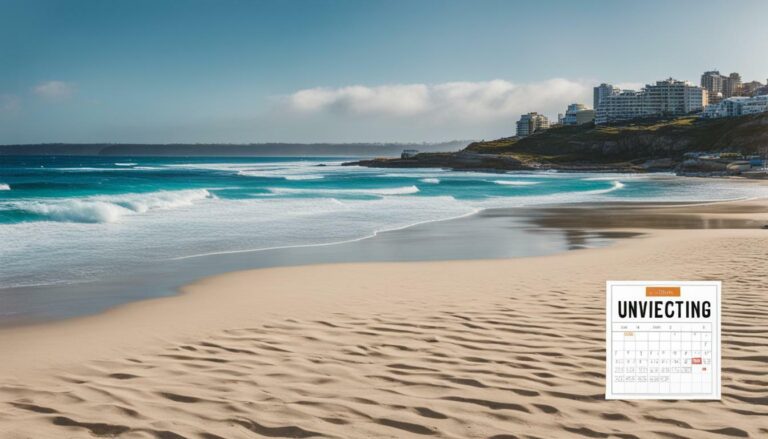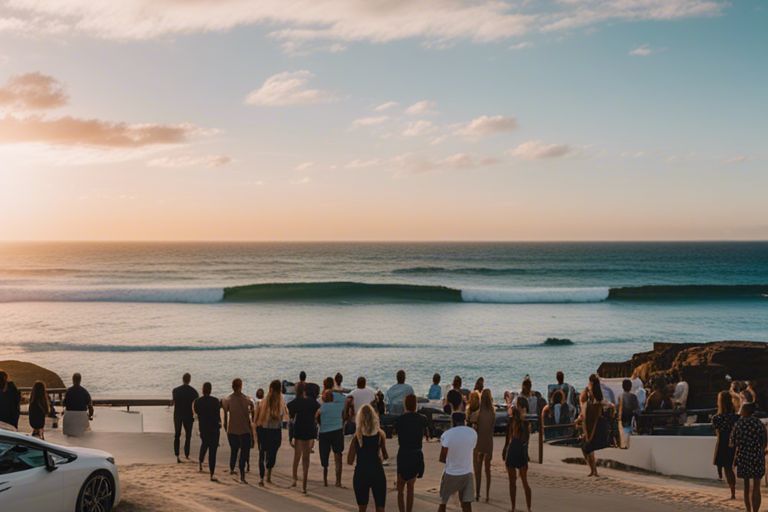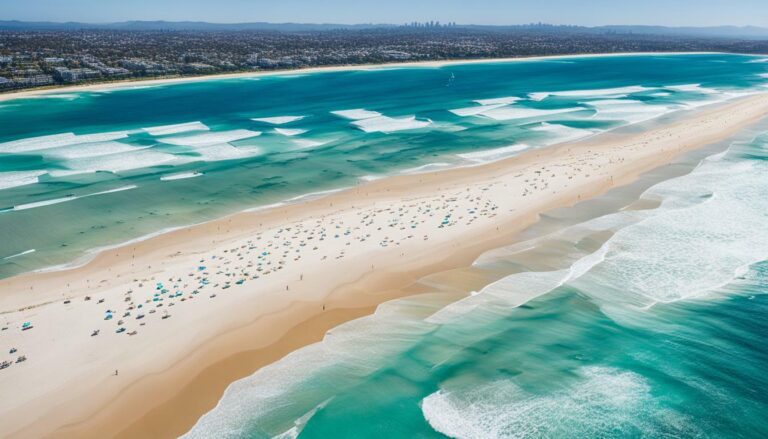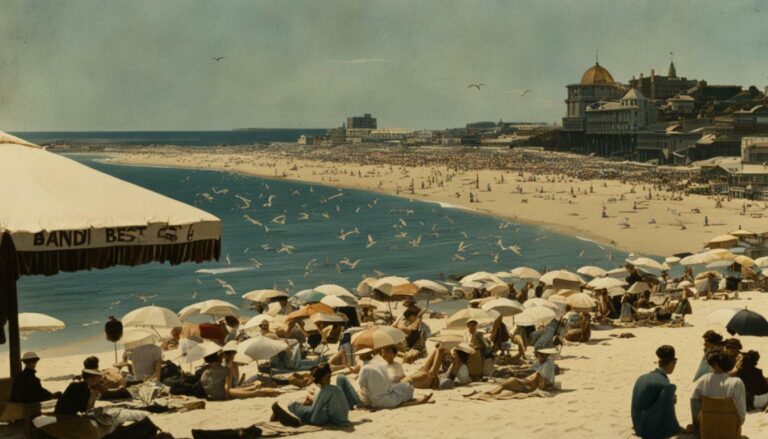Bondi’s Black Sunday: Facts and Legacy
Imagine a serene day at Bondi Beach, Australia, turning into one of the most monumental challenges for the local surf culture. Bondi’s Black Sunday transformed February 6, 1938, into a historical event so profound it shaped the principles of lifesaving that inform beach safety to this day. As the narrative of Bondi’s Black Sunday unspools, learn about the fateful surfing accident that saw heroes emerge and rescue missions that have left an indelible mark on this cherished Australian locale.
You’ll discover how this fateful day not only tested the mettle of the local lifeguards but also ignited a series of changes in beach safety protocols and lifeguard techniques. The collective bravery shown during the rescue efforts on that day etched a legacy into the heart of Bondi Beach and drove innovations that continue to keep ocean-lovers safe.
Key Takeaways
- Learn about the significant event known as Bondi’s Black Sunday and its historical context.
- Understand the critical role lifeguards played in the unprecedented rescue mission in 1938.
- Recognize how the events of Black Sunday have influenced Australia’s surf culture and beach safety measures.
- Explore the advancements in lifesaving techniques and equipment inspired by the tragedy.
- Reflect on the enduring legacy of this day and how it has shaped Bondi Beach as a symbol of resilience.
Understanding Bondi’s Black Sunday
As the waves of Bondi Beach crashed with unusual ferocity on February 6, 1938, a tranquil beach scene rapidly devolved into chaos. Bondi’s Black Sunday, as the event is now historically referred to, remains a critical pivot point in Australia’s surf culture and beach safety history. The massive surf produced a tragedy that tested and forever changed the lifeguard response protocols of the time. Let us navigate through the aspects that made this day a pivotal historical event.
The Historical Context of Bondi’s Black Sunday
You may wonder how a location as iconic as Bondi Beach could become the scene of such a tragedy. Bondi Beach’s transition from a landscape tended by Aboriginal peoples to one affected by settler colonialism invites us to consider more than the surf. It echoes a past where the environment was once respected and cared for, contrasting sharply with the challenges that arose under less sustainable management practices. The Black Sunday incident underscored the consequences of humanity’s disconnect with natural spaces.
Timeline of Events on the Tragic Day in 1938
On that fateful summer day, beachgoers could not have foreseen the peril that awaited them. It began with a typical sunny morning, inviting hundreds to the sandy shores of Bondi Beach. However, as observers enjoyed the warmth, rogue waves, reaching more than six feet in height, swept over the unsuspecting crowd. This resulted in a mass surfing accident that enveloped approximately 200 people in the turmoil of the surf, requiring an immediate and spirited lifeguard response.
Impact on Bondi Beach and the Surf Culture
The aftermath of Bondi’s Black Sunday resonated deeply within the Australian surf community. Not only did it bring forth the dangers lurking beneath the waves, but it also propelled a nationwide reflection on surf safety and the preparation of those charged with beachgoers’ safety. As a result, lifeguards honed their skills and techniques, and this tragedy significantly contributed to embedding a safety consciousness into the surf culture. Black Sunday remains an inflection point; its legacy still shapes the principles of lifesaving and serves as a reminder of nature’s unpredictable strength—where beauty and danger coalesce along Australia’s shores.
The Heroism of Lifeguards and Rescue Missions
As you delve into the heart-wrenching saga of Bondi’s Black Sunday, you’ll find that it was not just another day at Bondi Beach. In the summer of 1938, the surf became an amphitheater of lifeguard heroism as ordinary men transformed into saviors against crashing waves. This is a tale of valiant rescue missions demanded by unforeseen forces of nature that tested the resolve and bravery of those who watch over the iconic sands of Bondi Beach.
Witnessing unprecedented emergencies, the lifeguards were thrust into a cauldron of peril where their every action meant the difference between life and death. On this day, 1938 became a defining year in the annals of lifesaving history. Deftly managing mass rescue efforts amidst treacherous conditions, these guardians of the beach have etched an indelible legacy of courage.
Lifeguard Response to Unprecedented Emergencies
The protagonists of this historic day did not wear capes, but they soared to heroic heights nevertheless. Caught between routine and catastrophe, the lifeguards’ response to the emergencies before them was nothing short of remarkable. Faced with the convulsions of the ocean, they combatted the watery chaos with systematic precision and an unflinching will to save every soul in distress.
The Challenges of the Rescue Efforts
The challenges were immense; the crowd, unsuspecting; the waves, a monstrous surprise. The lifeguards faced daunting odds: hundreds of beachgoers were in an instant plight, their holiday revelry turned to a scramble for life. The sheer volume of those needing aid swiftly outstripped standard rescue protocols and pushed these brave souls into uncharted waters of lifesaving exertion.
Recognizing the Bravery Displayed
Yet, in this hour of need, stories of bravery surfaced like beacons of hope. The ceaseless efforts of each lifeguard, their quick decisions amidst the pandemonium, and their unrelenting determination in the face of fear, brought about a series of rescue missions that salvaged hundreds from the brink. Their bravery is a testament to the human spirit’s indefatigable force, revered and remembered by the sands of Bondi Beach.
In your journey through Bondi Beach’s past, remember the lifeguards’ courage during Bondi’s Black Sunday, a resonating part of Australia’s surfing saga. It’s essential to honor the past, acknowledge the sacrifice, and ensure the legacy of those who turned fear into acts of audacious heroism continues to inspire and instruct the guardians of Bondi’s future.
Bondi’s Black Sunday’s Influence on Safety Measures and Policies
When Bondi’s Black Sunday unfolded in 1938, the magnitude of the crisis became a catalyst for rigorous change in beach safety policies and lifeguard practices, not only in Australia but across the globe. Your understanding of today’s surf safety guidelines can be traced back to the pivotal lessons learned from that chaotic day at Bondi Beach.
In the wake of the disaster, Australian authorities scrutinized the events to shape a more systematic approach to the challenge of beachside safety. This period of reflection and reassessment marked the beginning of a tangible transformation, establishing foundational practices for modern lifeguard operations and public awareness.
As tragedy struck Bondi Beach on that fateful Sunday, it became starkly evident that even with the brave efforts of lifeguards, there was a dire need for improved safety measures to safeguard beachgoers against the powerful and unpredictable ocean.
A deeper dive into the incident’s aftermath undeniably showcases the enduring influence on safety measures and practices:
- Increased vigilance and monitoring of beach conditions
- Introduction of advanced lifesaving equipment
- Strengthening of communications and teamwork among the lifeguard community
- Enhanced safety signages and warnings for the public
- Development of comprehensive training programs for lifeguards
Let’s visualize the comparison between the pre-1938 and post-1938 beach safety measures:
| Aspect | Pre-Bondi’s Black Sunday (Prior to 1938) | Post-Bondi’s Black Sunday (After 1938) |
|---|---|---|
| Beach Monitoring | Minimal | Structured patrols, routine checks |
| Lifesaving Equipment | Basic | Integrated use of modern tools and devices |
| Lifeguard Training | Limited scope | Extensive training including first aid and rescue techniques |
| Public Awareness | Ad-hoc information | Regular educational campaigns and clear signage |
| Emergency Response | Reactive | Proactive and systematized |
With focused efforts, the landscape of Australian beach culture shifted, instilling a legacy of vigilance and preparedness within the fabric of Bondi Beach. Those systems and strategies, improved and honed over time, bolster the safety measures in place today, making them more adept at predicting risks and responding to emergencies. Your assurance of well-being stems from this historical turning point, underpinning the trust between lifeguards and the community, all stemming from the lessons of Bondi’s Black Sunday.
Lifesaving Innovations and Advancements Post-1938
In the aftermath of Bondi’s Black Sunday, a profound shift ensued, fundamentally reshaping the course of beach safety and rescue operations. The harrowing events of 1938 served as the impetus for significant lifesaving innovations and advancements. Witness how the technological developments and training improvements that emerged post-Black Sunday continue to influence public awareness and contribute to the enhancement of lifeguard equipment at Bondi Beach and beyond.

Technological Developments in Lifesaving Equipment
Since that crucial year of 1938, the realm of lifeguard equipment has undergone remarkable transformations. Technological advancements led to the invention and integration of cutting-edge gear designed to maximize rescue efficiency. Personal watercrafts, such as jet skis, now allow lifeguards to reach individuals in distress more rapidly. Sophisticated communication systems enable pinpoint coordination during multi-victim incidents, while advanced surveillance drones provide a bird’s eye view to spot any trouble long before it reaches the shore.
Training Improvements for Future Lifeguards
Modern-day lifesavers benefit from comprehensive and meticulously developed training programs—a stark contrast to their predecessors. The focus has expanded from sheer physical readiness to also incorporate critical thinking under pressure, rescue strategy, and emergency medical interventions. Simulation drills and continuous education ensure that the lifeguards of today and tomorrow are well-equipped both mentally and physically to face the unpredictable ocean.
Changes in Public Awareness and Education
The unfortunate loss of life on Bondi Beach back in 1938 catalyzed a renewed effort in bolstering public awareness about marine hazards. Safety campaigns, which educate beachgoers on the dynamics and dangers of the ocean, became a priority. Policy and education coalesce as visitors are now routinely informed about weather conditions, riptides, and how to swim safely. This preventative strategy fundamentally strengthens the bond between lifeguards and beachgoers, embodying a shared commitment to safety at Bondi Beach.
As you explore the evolution of lifeguard protocols and equipment, it’s clear that the tragic legacy of Bondi’s Black Sunday has ultimately led to a safer, more informed public enjoying the coastal beauty of Bondi Beach. Lifesaving is not just about the bravado of saving lives; it’s about innovation, continuous improvement, and fostering a culture of awareness and respect for nature’s power.
Documentary and Literary Interpretations of Bondi’s Black Sunday
When surf culture media intersects with historical events, the result can often be as impactful as the original events themselves. Such is the case with Bondi’s Black Sunday, a day etched into Australia’s collective memory through various documentary and literary interpretations.
Incorporating Tragedy into Surf Culture Media
In surf-centric Australia, the narratives of heroism and tragedy from Bondi’s Black Sunday have been captured and retold in numerous forms of media. These retellings serve not only to document the factual details, but also to explore the emotional and cultural implications of this watershed moment. Through surf magazines, films, and special television features, the story of Black Sunday has been carefully woven into the very fabric of the Australian surf community.
Reflections through Documentaries and Historical Accounts
Documentaries about Bondi’s Black Sunday provide a powerful visual narrative that brings the events to life. Directors and historians delve into the context, aftermath, and personal stories that emerged from the tragedy. Through interviews with survivors, rescuers, and experts, these documentaries deepen our understanding of Bondi’s Black Sunday and reinforce its significance as a historical event that still resonates today.
The Role of Literature in Preserving Collective Memory
Literature has a unique role in capturing and preserving the human experiences behind historical events. Works of fiction and non-fiction regarding Bondi’s Black Sunday offer literary interpretations that help embed this piece of history into Australia’s collective memory. Novels, poems, and historical accounts provide platforms for the stories of the individuals affected to live on, ensuring their legacy is passed down to future generations.
Whether it’s through the lens of a camera or the pen of an author, the interpretations of Bondi’s Black Sunday continue to shape Australia’s understanding of its own history. These media ensure that the lessons learned are remembered, the bravery honored, and the lost mourned. As you delve into these diverse retellings, you connect with past events in a way that is as educational as it is profound, contributing to a larger conversation about Australia’s cultural and environmental identity.
Conclusion
As the sun sets on the sands of Bondi Beach, you carry with you the heavy yet invaluable treasure chest of lessons learned from Bondi’s Black Sunday. The events of that day in 1938 are etched into the fabric of Australia’s cultural memory, serving as a stark reminder of the ocean’s unpredictable power and the imperative of persistent vigilance. The enduring legacy of Black Sunday is reflected in the strengthened bond between those who enjoy the beach and the stalwart individuals committed to their safety—a testament to a community united by trial and now fortified by understanding.
Lessons Learned and the Enduring Legacy
The surf community’s proactiveness borne from the tragedy of Black Sunday has wired an enduring legacy into Australia’s beach culture. You witness today the results of a society that has turned reflection into action, and sorrow into strategy, ensuring that such heartache served as a catalyst for change rather than just a momentary cry in history. Lifeguards now stand better equipped, the general public more educated, and all are more aware of the oceans’ swift moods—lessons that underscore the importance of remembering and learning from historical events.
Bondi Beach Today: A Testament to Resilience
Your gaze upon Bondi Beach today reveals more than panoramic vistas; it unveils a chapter of resilience written into the golden grains by those who dared to learn and grow from the adversity of Black Sunday. The beach now buzzes with the protective heritage of improved safety measures and protocols, all the while maintaining its spirit as a sanctuary for swimmers and surfers alike—a spirit unyielding to the tides of time and confident in the hands that continue to shape its shores.
Commemorating Bondi’s Black Sunday in Australian History
In commemorating the historical events of Black Sunday, you participate in a rite that extends beyond mere memory; you engage in an active promise to future generations that Australia will neither shy away from its past nor the lessons gleaned. As we stand on the shoulders of the visionary individuals who reshaped Australia’s approach to lifesaving and beach safety, we ensure that our past, with its trials and triumphs, remains an indomitable guide to safeguarding the future of Bondi Beach and all its patrons.
FAQ
What was Bondi’s Black Sunday?
Bondi’s Black Sunday refers to a devastating event that took place on February 6, 1938, when massive waves hit Bondi Beach in Sydney, Australia, leading to a large-scale surfing accident. Lifeguards undertook a massive rescue mission to save hundreds of swimmers swept out to sea.
How many people were affected by Bondi’s Black Sunday?
On Bondi’s Black Sunday, it is estimated that around 250 people were rescued from the turbulent waters, while tragically, five lives were lost. The event is considered one of the largest mass rescues in Australia’s surf lifesaving history.
What was the historical context behind Bondi’s Black Sunday?
Before the settler colonialist influence, Bondi Beach was managed by Aboriginal people. The events of Bondi’s Black Sunday unfolded within a broader history of transforming the beach towards recreational use, a process that did not always acknowledge or incorporate the wisdom of Indigenous practices in beach safety and management.
What was the impact of this event on surf culture?
Bondi’s Black Sunday had a profound impact on surf culture, leading to increased attention to beach safety and lifeguard protocols. It served as a catalyst for change, emphasizing the importance of preparedness and vigilance in surfing and beach activities.
How did lifeguards respond to the emergencies during Bondi’s Black Sunday?
Lifeguards on Bondi Beach responded with exceptional bravery and quick thinking, coordinating rescue efforts under enormous pressure. They faced the challenge of saving an unprecedented number of swimmers in distress due to the powerful sudden waves.
What changes were made in safety measures and beach policies after the 1938 event?
Following Bondi’s Black Sunday, there were substantial reforms to beach safety measures and policies, including the implementation of stricter guidelines, more systematic approaches to safety, and improved equipment and techniques for lifeguarding.
What technological developments in lifesaving equipment occurred after the incident?
Post-Bondi’s Black Sunday, innovations in lifesaving equipment included the development of more effective rescue boards, jet skis, and advancements in communication devices that enabled quicker and more efficient responses to emergencies.
How did the training for future lifeguards improve as a result of Bondi’s Black Sunday?
Training for future lifeguards became more rigorous, with programs focusing on both physical skills and the ability to make quick decisions under pressure. There was also an emphasis on teamwork and rescue strategy, reflecting the lessons learned from the 1938 tragedy.
How have public awareness and education changed due to Bondi’s Black Sunday?
Since Bondi’s Black Sunday, there has been a significant push to enhance public awareness and education on beach safety. This includes increased signage, educational programs, and campaigns to inform beachgoers about the potential risks of the ocean and the importance of following lifeguard instructions.
How have documentaries and literary works contributed to the understanding of Bondi’s Black Sunday?
Documentaries and literary works have played a critical role in preserving the memory of Bondi’s Black Sunday and fostering an understanding of its significance within Australian history and surf culture. These media provide vivid and insightful perspectives on the tragedy, the heroism involved in the rescues, and the aftermath of the event.







